|

by Jason Jarrell and Sarah Farmer
November
2017
from
Ancient-Origins Website
|
Jason Jarrell
and Sarah Farmer are investigative historians and avocational
archaeologists.
They study many
subjects including depth psychology, Biblical mysteries, political
science, and comparative mythology.
They're also
authors of Ages of the Giants: A Cultural History of the Tall Ones
in Prehistoric America (2017).
Learn more at
their website:
ParadigmCollision |
Part I
Who Were These
Beings of Ancient Astronaut Theory?
November 19, 2017
Updated
May 20, 2021

Top Image:
Ordered universe and cuneiform (Public Domain)
and Akkadian cylinder featuring Anunnaki.
Public Domain - Deriv.
The modern era has witnessed an incredible surge in the popularity
of all forms of media concerning the mythology of the ancient
Mesopotamians.
Fueling this ever-growing
trend are the writings of a number of researchers who propose
connections between several Sumerian myth cycles and the theory that
the human race was engineered or created by a group of
extraterrestrial beings.
Known as Ancient
Astronaut Theory, this field is largely reliant upon the
translations of cuneiform tablets supposedly made by
Zecharia Sitchin, whose series
of Earth Chronicles books form the foundation upon which the
modern church of the alien gods has been built.
Central to Sitchin's narrative is a group of mythic beings known as
the Anunnaki, whom he claimed
crossed their own DNA with that of Homo erectus in order to create
mankind - for the purpose of using humans as slaves to mine gold and
other minerals.
Today these Anunnaki are
often portrayed as the equivalent of the Old Testament creator
God.

Anunnaki created mankind?
(Public
Domain)
But what does the cuneiform corpus actually say about the Anunnaki
and other mythic beings?
How does the version of
these beings and their activities presented in Ancient Astronaut
media compare with how they were truly represented in the ancient
world?
Princely Blood
To begin with, Anunnaki translates to "princely blood" or "seed of
Anu", not "those who came down" or "those who came from heaven to
earth", as many modern sources have claimed.
The Anunnaki are "the
Sumerian deities of the old primordial time;" a pantheon of gods who
were the children of the sky god Anu and his sister, Ki.
Significantly, some
scholars have come to realize that the Anunnaki should more
appropriately be considered demi-gods or semi-divine beings.
Apparently, Anu's sister
Ki was not originally considered a deity and was only ascribed the
status of a goddess much later in the history of the myth cycle.
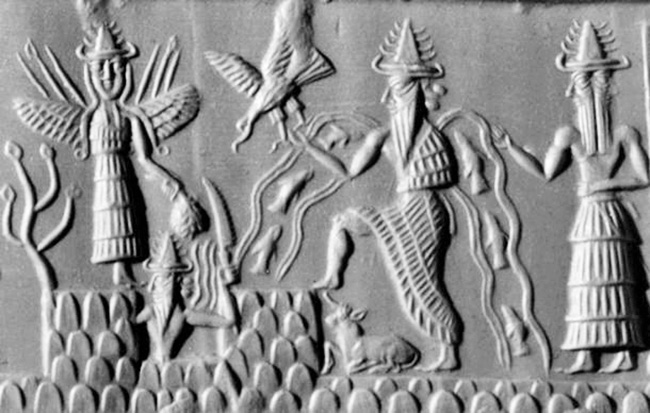
Akkadian cylinder seal dating to circa 2300 BC
depicting the deities Inanna, Utu, and Enki,
three
members of the Anunnaki.
(Public
Domain)
As explained by William Klauser:
"Some authorities
question whether Ki was regarded as a deity since there is no
evidence of a cult and the name appears only in a limited number
of Sumerian creation texts.
Samuel Noah Kramer
identifies Ki with the Sumerian mother goddess Ninhursag and
claims that they were originally the same figure.
She later developed
into the Babylonian and Akkadian goddess Antu, consort of the
god Anu (from Sumerian An)."
Essentially, this would
mean that the Anunnaki were born of a union between a sky god and a
mortal female, who was later deified in mythic traditions.
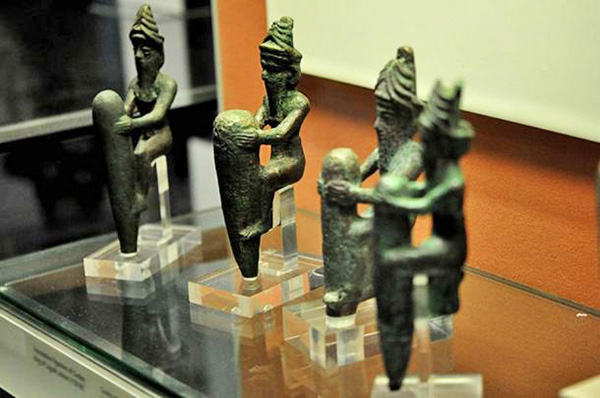
Four copper-alloy statuettes dating to c. 2130 BC,
depicting four ancient Mesopotamian gods,
wearing characteristic horned crowns.
(Osama Shukir Muhammed Amin/ CC BY-SA 3.0)
From Dust to
Dust
Furthermore, "Ki" is the Sumerian sign for "earth", and Anu's
consort is sometimes considered the personification of the earth
itself.
This is similar to
Biblical tradition, where mortals were created out of the dust
of the earth (Genesis 2:7).
The concept of a group of
half-divine beings born of mortal women is very similar to the
Biblical and extra-Biblical tradition of the Nephilim.
One of the most heavily referenced ancient texts which describes
the Nephilim is the Extra-Biblical Book of 1 Enoch
attributed to the patriarch Enoch, son of Jared and father of
Methuselah. 1
Enoch is considered an
apocryphal text today, and is rejected by most mainstream
theological establishments, but this was not always the case.
Many of the early Church
Fathers, such as Athenagoras, Clement of Alexandria,
Irenaeus and Tertullian accepted the book as
scripture, and fragments of 10 copies of 1 Enoch in Aramaic have
been found among the
Dead Sea Scrolls.
1 Enoch is also quoted in
the Biblical Book of Jude, and it has been estimated that there are
as many as several hundred more references throughout the New
Testament itself.
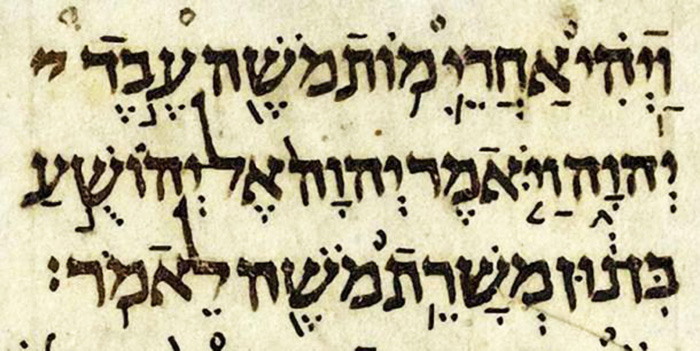
Joshua 1:1 as recorded in
the Aleppo Codex, 10th century AD
(Public Domain)
Sons of God,
Daughters of Man
The most famous portions of 1 Enoch feature an elaboration on
certain events before the deluge recorded in the Bible (specifically
Genesis chapter 6, verses 1-4).
According to 1 Enoch, a
group of 200 fallen angels known as
the Watchers, led by an individual
named Semyaza (or Semjaza) descended upon Mount Hermon, where
they swore an oath to father lineages with human women.
Each of these,
"took unto themselves
wives, and each chose for himself one, and they began to go in
unto them and to defile themselves with them", a union which
resulted in the birth of "great giants".
These giants eventually,
"consumed all the
acquisitions of men", and, "when men could no longer sustain
them, the giants turned against them and devoured mankind."
(1
Enoch, Ch. 6-7)
These activities provoke
the action of God, who curses the giants to war against one another,
"that they may
destroy each other in battle", and sends the archangels to bind
the Watcher leadership "in the valleys of the earth".
(1
Enoch 10)
As is well known today,
the Hebrew texts refer to the powerful
beings born to the Watchers as The Nephilim.
Location of
the Sanctuary of the Anunnaki
Scholars have found profound similarities between the mythologies of
the Anunnaki and the Nephilim.
In 1971, Edward
Lipinski published a scholarly analysis of several ancient
texts, including the Old Babylonian version of
The Epic of Gilgamesh, all which
feature important details revealing the true location of the
sanctuary of the Anunnaki in ancient Eastern thought and cosmology.
Lipinski found that:
"In fact, the Old
Babylonian version of the [Gilgamesh Epic] identifies Hermon and
Lebanon with the dwelling of the Anunnaki".
He emphasizes lines 12-21
of the Old Babylonian Gilgamesh, which tell of the destruction of
Humbaba, the guardian of the abode of the gods at the hands of
Gilgamesh's companion Enkidu, after which the text states
that the two,
"penetrated into the
forest, opened the secret dwelling of the Anunnaki."
While later mythologies
suggest alternate locations for the home of the Anunnaki, Lipinski
explains that the oldest Mesopotamian and Near Eastern Canaanite
texts point to the Cedar forest of Mount Hermon:
"... traces of the
older tradition can be found in the mention of the mountain
which was the abode of the gods, and whose accesses were hidden
by the Cedar Forest whose guardian was Humbaba.
This mountain was, we
believe, the Anti-lebanon-Hermon...
The southern range of
the Anti-Lebanon is therefore likely to be the mountain in whose
recesses the Anunnaki dwelled according to the Old Babylonian
version of the Gilgames epos.
In the Old Babylonian
period the Anunnaki were still the gods in general...
Mount Hermon should
thus be identified with the dwelling of the gods."
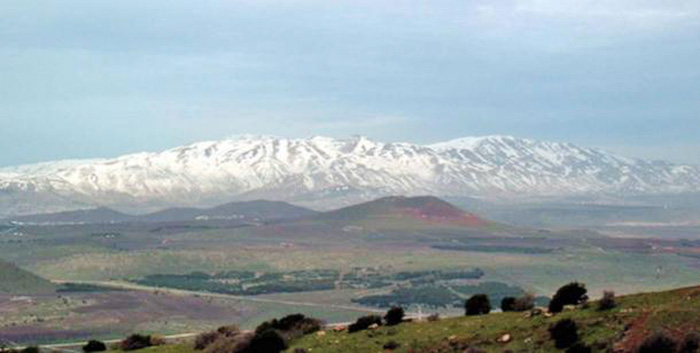
Snowy Mount Hermon.
(Public
Domain)
Heaven and Earth Join
Lipinski also points out the fact that Mount Hermon was considered
the guardian of international treaties in the ancient world, and
connects this tradition with the oath sworn by the Watchers
in
1 Enoch.
Incorporating apocryphal
texts such as the
Testaments of the Twelve Patriarchs
and 1 Enoch into his study, Lipinski concludes:
"Mount Hermon is the
cosmic mountain which joins the earth with the lowest heaven.
The same conception lies behind the episode of the sons of
God in the
Book of Enoch.
The celestial beings
gather on the summit of Mount Hermon because this is the
mountain of the gods, the Canaanite Olympus."
Mount Hermon is located
at the southern end of the Anti-Lebanon mountain range, straddling
the borders of Syria and Lebanon.
Hermon's highest peak
reaches 9,232 feet (2814 meters). The area abounds with ancient
altars going back millennia, and was still the host of shrines and
rituals as recently as the time of Constantine the Great.
Of further significance
is the fact that Gilgamesh was renowned in the ancient world for
obtaining knowledge from the pre-flood (or "antediluvian") world, as
stated by the Ugarit Epic of Gilgamesh (lines 5-9):
"He explored
everywhere the seats of power, he knew the totality of wisdom
about all things. He who travelled the distant road to Utter-napisti,
who crossed the ocean, the wide sea, as far as the sunrise: he
brought back tidings from the antediluvian age."
These passages bring us
full circle with Lipinski's interpretation of the Old Babylonian
version of the Gilgamesh epic, where the ancient king journeyed to
Mount Hermon - abode of the Anunnaki...
Part II
Finding
the Nephilim in Myth, Giants Among Men
November 16, 2017
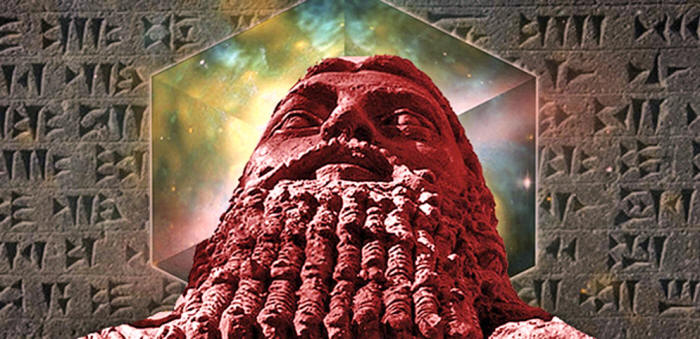
Top Image:
Ordered universe and cuneiform (Public Domain)
and
statue of Gilgamesh.
CC BY 2.0 - Deriv.
Central to
Ancient Astronaut Theory and author
Zecharia Sitchin's narrative,
is a group of mythic beings known as
the Anunnaki, whom he claimed
crossed their own DNA with that of Homo erectus in order to create
mankind - for the purpose of using humans as slaves to mine gold and
other minerals.
Today these Anunnaki are
often portrayed as the equivalent of the Old Testament creator
God.
But what does the
cuneiform corpus actually say about the Anunnaki and other
mythic beings?
How does the version
of these beings and their activities presented in Ancient
Astronaut media compare with how they were truly represented in
the ancient world?
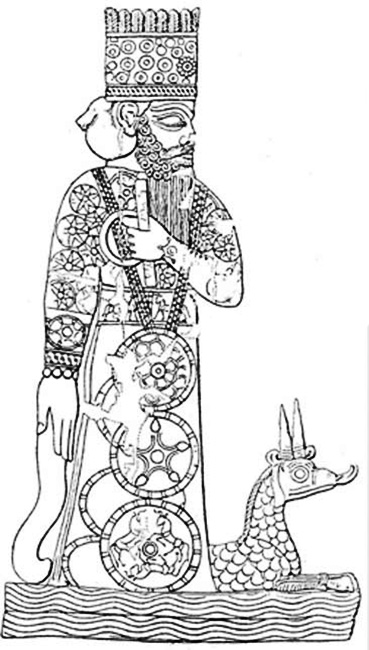
Babylonian representation
of the
national god Marduk,
who was
envisioned as
a
prominent member of the Anunnaki
(Public
Domain)
Mount Hermon is located at the southern end of the Anti-Lebanon
mountain range, straddling the borders of Syria and Lebanon.
Hermon's highest peak reaches 9,232 feet (2814 meters).
Gilgamesh was renowned in
the ancient world for obtaining knowledge from the pre-flood (or
"antediluvian") world, as stated by the Ugarit
Epic of Gilgamesh
(lines 5-9):
"He explored
everywhere the seats of power, he knew the totality of wisdom
about all things. He who traveled the distant road to Utter-napisti,
who crossed the ocean, the wide sea, as far as the sunrise: he
brought back tidings from the antediluvian age."
These passages bring us
full circle with Lipinski's interpretation of the Old Babylonian
version of the Gilgamesh epic, where the ancient king journeyed to
Mount Hermon - abode of the Anunnaki.
Gilgamesh, the
Giant
The concept of ancient knowledge from the pre-flood world is
actually inherent in many Eastern traditions.
For example, there is a
similar story in the apocryphal
Book of Jubilees about Kainam,
a son of the Biblical Arphaxad:
"And the son grew,
and his father taught him writing, and he went to seek for
himself a place where he might seize for himself a city.
And he found a
writing which former generations had carved on the rock, and he
read what was thereon, and he transcribed it and sinned owing to
it; for it contained the teaching of the Watchers in accordance
with which they used to observe the omens of the sun and moon
and stars in all the signs of heaven.
And he wrote it down
and said nothing regarding it; for he was afraid to speak to
Noah about it lest he should be angry with him on account of
it."
(Jubilees 8:1-5)
Interestingly, there are
several ancient sources, which suggest that Gilgamesh himself was a
half-god or semi-divine being of gigantic stature.
According to the Sumerian
Kings List, Gilgamesh was the 5th king of Uruk, who reigned sometime
between 2800 and 2600 BC.
While there are
traditions considering the father of Gilgamesh to be king Lugalbanda,
the Sumerian Kings List states that his true father was a "lillu-spirit,
a high priest of Kulaba", and he is described in the epic as
"two-thirds god".
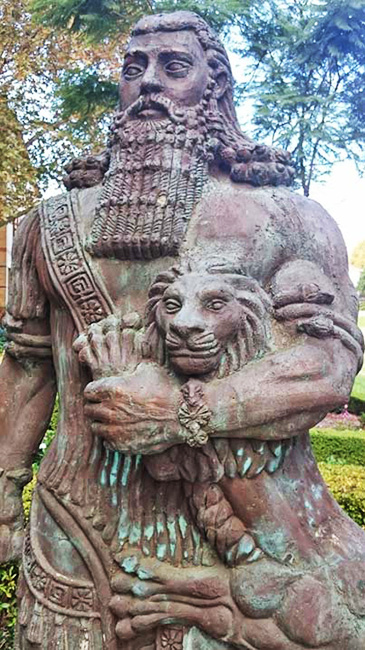
Gilgamesh Statue
(Gwil5083/
CC BY-SA 4.0)
Gilgamesh is believed to have attained victory over the kings of
Kish, centralizing Uruk's power, and tradition has him expanding the
city of Uruk, including its temple precinct and walls.
In several fragments of a
twelfth-century-BC copy of the Gilgamesh Epic discovered at ancient
Ugarit, Gilgamesh is described as,
"Surpassing all
(other) kings (!), renowned for bodily stature" (line 16) and
again as "Gilgames, renowned for bodily stature, hero born in
Uruk, butting wild bull!" (lines 18-19).
Lines 34-36 of the Ugarit
Gilgamesh offer specific details on Gilgamesh's size:
"Eleven cubits was
his height, four cubits the width of his chest. A triple cubit
was his foot and a reed-length his legs".
According to these
measurements, Gilgamesh would have stood between 16 and 18 feet tall
(4.8 to 5.4 meters tall).
In connection to
Gilgamesh being a giant, the fragmentary
Book of Giants from the Dead
Sea Scrolls names several Nephilim giants as Ohya, Mahway, Hahya,
and Gilgamesh.

Gilgamesh,
the king-hero from the city of Uruk,
battling the 'bull of heavens'
(0045269/ CC BY-SA 4.0)
Giants
Reigning on Mount Hermon
Returning to the subject of Mount Hermon, Gilgamesh is not the only
ancient giant directly associated with this prominent locale.
Several Old Testament
books (The Book of Numbers, Deuteronomy, and The Book of Joshua)
record the battle of Moses and the Israelites against Og, an Amorite
king of Bashan.
In Deuteronomy 3:11 (KJV),
Og is described as "of the remnant of giants", and his bed (or
sarcophagus) is measured as nine cubits long and four cubits wide,
meaning that Og himself may have been 12 or 13 feet in height
(approx. four meters tall).
In Joshua 4:5 (KJV), it is revealed that Og "reigned in mount Hermon,
and in Seclah, and in all Bashan", a region which would include the
slopes of Mount Hermon and the Golan Heights.
Entities of
the Underworld
Still another factor connecting the Anunnaki with the story of the
Watchers and their offspring is their status as underworld beings.
In Mesopotamian cycles,
the Anunnaki are frequently depicted as "fates" or judges of the
dead who occupy the subterranean realm or function as "spirits of
the earth".
In tablets discovered at
Nippur from around 2000 BC, the Anunnaki are "the seven judges",
underworld entities that accompany Ereshkigal, queen of the
subterranean realm.
When Ishtar descends and
is brought before the assembly, they fasten their "eyes of death"
upon her, causing her to perish.
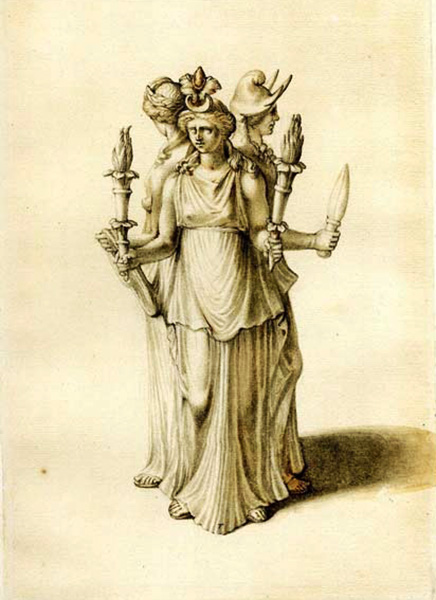
An early nineteenth-century drawing
of a
statuette of Hecate,
with
whom Ereshkigal was syncretized.
(Public
Domain)
Cast Down into
Hell
The mountain abode of the Canaanite god, El is also frequently
associated with secret or hidden natural springs and underground
rivers.
Lipinski associates these
connotations with the sources of the Jordan River, one of which is
the spring of Banias, originating at the foot of Mount Hermon.
He furthermore elaborates
that the mountain was considered in ancient times to cover,
"one of the outlets
of the Deep or Ocean from which came the waters of the Flood...
an eruption of the subterranean ocean on which the earth was
believed to rest."
In 1 Enoch, God
commands the archangel Michael to,
"Go, bind Semjaza and
his associates who have united themselves with women... bind
them fast for seventy generations in valleys of the earth..." (1
Enoch 10:11-12), while Raphael is commanded, "Bind Azazel hand
and foot, and cast him into the darkness: make an opening in the
desert, which is in Dudael, and cast him therein." (1 Enoch
10:4)

Ancient Hittite relief carving from Yazılıkaya,
a
sanctuary at Hattusa, depicting
twelve
gods of the underworld,
whom
the Hittites identified
as the
Mesopotamian Anunnaki.
(Klaus-Peter Simon/ CC BY 3.0)
There are also references to the fate of the Watchers in New
Testament books, including Second Peter, which states,
"...God spared not
the angels that sinned, but cast them down to hell, and
delivered them into chains of darkness..."
(2nd
Peter, 2:4, KJV)
The word translated as
"hell" in this verse is actually the Greek Tartarus,
referencing the deepest underworld of Greek mythology - the prison
of the Titans.
Not only were the Titans giants, but like the Anunnaki, they were
the offspring of an earth goddess (Gaia) and a sky deity (Uranus).
Some scholars consider it likely that the Greek mythos was largely
based on the older Eastern Mythologies.
The same concept is
repeated again in the Book of Jude, verse 6, which mentions,
"the angels which
kept not their first estate, but left their own habitation, he
hath reserved in everlasting chains under darkness".

One of the giant Titans, Atlas,
who was punished to bear
the heavens on his shoulders for all time.
(Public Domain)
The True
Identity of the Anunnaki
It is widely known that the archetypal myth cycles of the
Mesopotamian and Near Eastern traditions share a common origin, and
that the subjects of these cycles also appear in the Biblical,
extra-Biblical, and even Quranic texts.
The purpose of this
article is to identify the specific mythic concept behind the
Anunnaki in the ancient world.
Contrary to much of the popular literature and other media of today,
the evidence recorded by the academic research of scholars and a
comparative study of the actual cuneiform and other ancient texts,
indicates that the true identity of the Anunnaki is to be found in
the Eastern tradition of a group of half-gods, spawned by
cross-breeding between divine beings and mortal females at Mount
Hermon in the Anti-Lebanon mountain range.
These beings are often
associated with knowledge from the world before a great deluge and
were later assigned roles in the underworld.
This would suggest that
rather than making the Anunnaki the equivalent of the "Elohim" who
created man in the Book of Genesis; they should more
properly be compared to the Nephilim and the fallen angels described
in Genesis Chapter 6, 1 Enoch, and other extra-biblical texts.
References
-
David Leeming,
The Oxford Companion to World Mythology, Oxford University
Press, Oxford, N.Y., 2005.
-
William Klauser,
The Esoteric Codex: Deities of the Underworld, lulu.com,
2015.
-
Compare Jude 1:
14-15 (KJV) with 1 Enoch 1:9.
-
Edward Lipinski,
"El's Abobe: Mythological Traditions Related to Mount Hermon
and to the Mountains of Armenia", in Orientalia Lovaniensa
Periodica 2, Leuvan, 1971, pp. 13-69.
-
Maureen Gallery
Kovacs "Introduction",
The Epic of Gilgamesh,
Stanford University Press, California, 1989.
-
Andrew R. George,
"The Gilgames epic at Ugarit", Aula Orientalis 25, 2007, pp.
237-254.
-
Alexander Heidel,
The Gilgamesh Epic and Old Testament Parallels, University
of Chicago Press, Chicago & London, 1946
|














